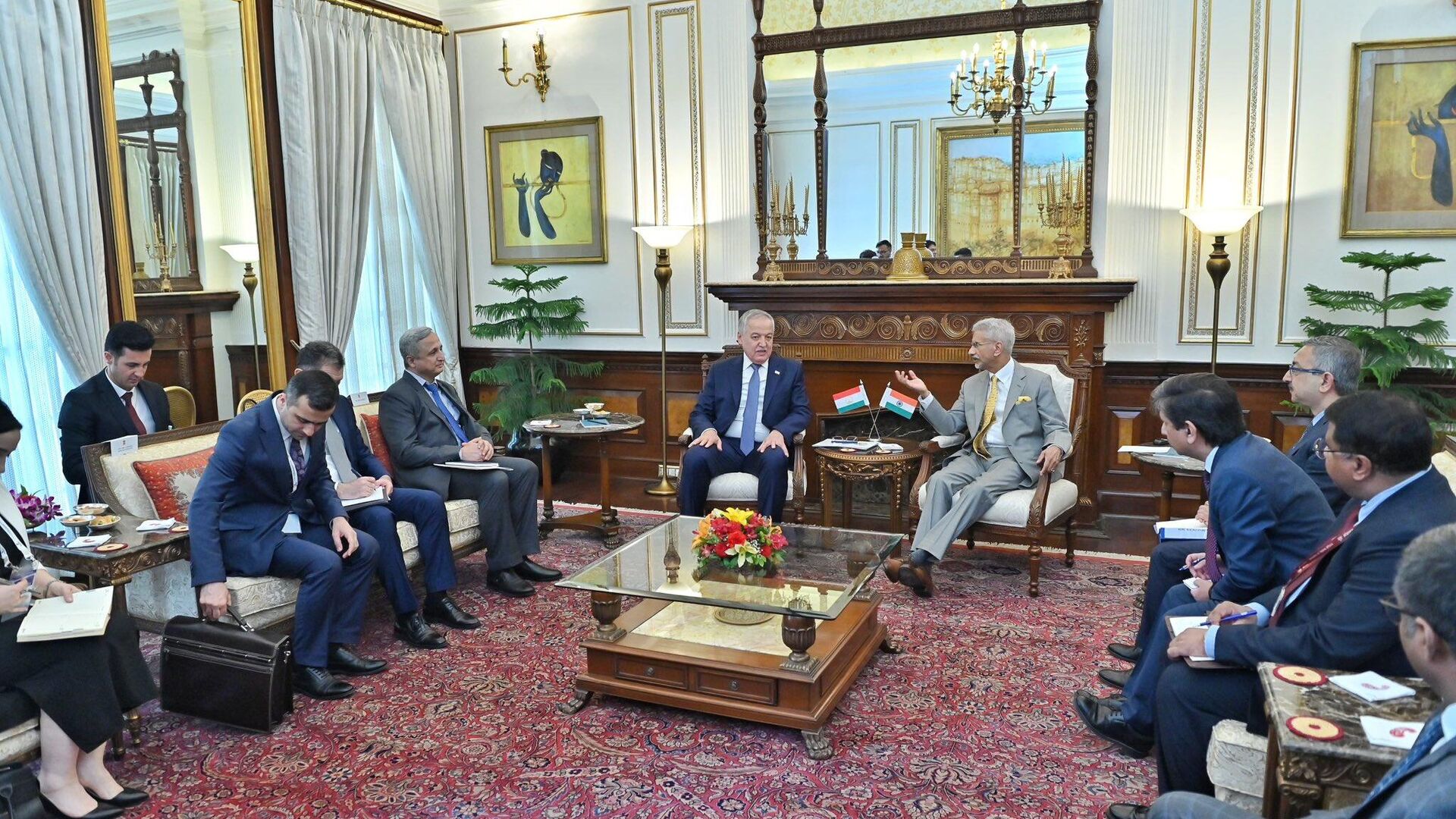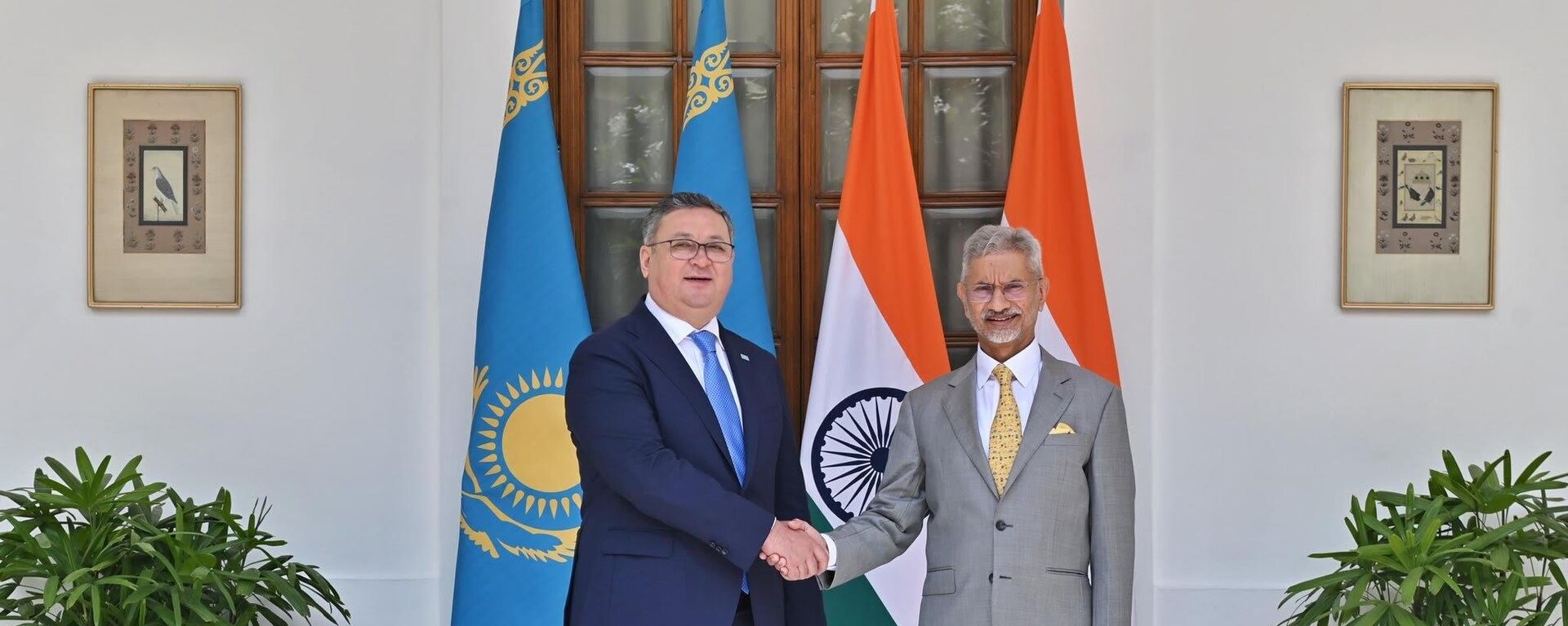https://sputniknews.in/20250605/jaishankar-pushes-rupee-trade-digital-ties-and-chabahar-port-with-central-asia-9243886.html
Jaishankar Pushes Rupee Trade, Digital Ties and Chabahar Port with Central Asia
Jaishankar Pushes Rupee Trade, Digital Ties and Chabahar Port with Central Asia
Sputnik India
From rail and port logistics to digital payments and fintech, Indian Minister of External Affairs S Jaishankar outlines New Delhi's ambition to become the trade and technology partner for Central Asia — with Chabahar at its heart.
2025-06-05T21:06+0530
2025-06-05T21:06+0530
2025-06-05T21:06+0530
s. jaishankar
india
central asia
chabahar port
https://cdn1.img.sputniknews.in/img/07e9/06/05/9244032_0:68:2048:1220_1920x0_80_0_0_f1714b3f1a3ebeae0c86b999bd4e8201.jpg
India is betting on Iran's Chabahar Port and digital platforms such as UPI to deepen its strategic and economic engagement with Central Asia.That was the message from External Affairs Minister Dr S Jaishankar to the inaugural meeting of the India-Central Asia Business Council in New Delhi on Thursday.Welcoming diplomats, industry leaders and trade officials in Russian and other languages, Jaishankar stressed that Chabahar Port, developed with Indian assistance, plays a pivotal role in the International North–South Transport Corridor.The corridor offers Central Asia direct access to the Arabian Sea, bypassing Pakistan and reducing travel distance and costs.India sees it as a strategic alternative to China’s Belt and Road Initiative and its China-Pakistan Economic Corridor.The foreign minister pointed out that although India’s trade with Central Asia has grown over the past decade — from less than $500 million in 2014 — it still falls short of its true potential.He urged Central Asian partners to recognise the demand potential of India’s $4 trillion economy, which is growing at six to eight percent annually, stressing that the growth will lead to “new demands for products, services and more prosperous lifestyles.”“We need to diversify our trade baskets so that all of us have more options, more competition, and, in a way, we are looking for new opportunities,” Jaishankar stressed.The minister also made a strong case for extending India’s digital innovations to Central Asia, citing cross-border digital payments, Aadhaar and DigiLocker as models for financial inclusion and seamless digital governance, highlighting how digital technology and AI applications can unlock the full trade potential between the two regions.He also highlighted the need to diversify bilateral trade settlements away from the US dollar.He urged wider adoption of Unified Payments Interface and national currency settlements in cross-border trade, supporting efforts to aid mutual settlement of trade in national currencies.Despite progress, Jaishankar acknowledged challenges to land and air connections, calling for more coordinated infrastructure development and investment.“This will require more resources and effort in the International North–South Transport Corridor. Greater utilisation of Chabahar Port can significantly reduce travel distances and costs,” Jaishankar said.He also stressed the need to streamline trade logistics and reduce bureaucratic friction across borders.“We need to simplify customs procedures using tools like the ATA Carnet to ease the flow of goods between India and all Central Asian countries,” Jaishankar argued.
https://sputniknews.in/20250605/chabahar-north-south-corridor-in-focus-as-india-hosts-top-diplomats-from-central-asia-9240844.html
india
central asia
chabahar port
Sputnik India
feedback.hindi@sputniknews.com
+74956456601
MIA „Rossiya Segodnya“
2025
Sputnik India
feedback.hindi@sputniknews.com
+74956456601
MIA „Rossiya Segodnya“
News
en_IN
Sputnik India
feedback.hindi@sputniknews.com
+74956456601
MIA „Rossiya Segodnya“
Sputnik India
feedback.hindi@sputniknews.com
+74956456601
MIA „Rossiya Segodnya“
s jaihankar, chabahar port, iran, india, central asia, india-central asia business council, international north–south transport corridor, china’s belt and road initiative and its china-pakistan economic corridor
s jaihankar, chabahar port, iran, india, central asia, india-central asia business council, international north–south transport corridor, china’s belt and road initiative and its china-pakistan economic corridor
Jaishankar Pushes Rupee Trade, Digital Ties and Chabahar Port with Central Asia
From rail and port logistics to digital payments and fintech, Indian Minister of External Affairs S Jaishankar outlines New Delhi's ambition to become the trade and technology partner of choice for Central Asia — with Chabahar at its heart.
India is betting on Iran's Chabahar Port and digital platforms such as UPI to deepen its strategic and economic engagement with Central Asia.
That was the message from External Affairs Minister Dr S Jaishankar to the inaugural meeting of the India-Central Asia Business Council in New Delhi on Thursday.
Welcoming diplomats, industry leaders and trade officials in Russian and other languages, Jaishankar stressed that Chabahar Port, developed with Indian assistance, plays a pivotal role in the International North–South Transport Corridor.
The corridor offers Central Asia direct access to the Arabian Sea, bypassing Pakistan and reducing travel distance and costs.
India sees it as a strategic alternative to China’s Belt and Road Initiative and its China-Pakistan Economic Corridor.
The foreign minister pointed out that although India’s trade with Central Asia has grown over the past decade — from less than $500 million in 2014 — it still falls short of its true potential.
“The need to address this is even more urgent today because of the uncertainties in the international economy. This requires the government and businesses to work together in tandem,” Jaishankar said.
He urged Central Asian partners to recognise the demand potential of India’s $4 trillion economy, which is growing at six to eight percent annually, stressing that the growth will lead to “new demands for products, services and more prosperous lifestyles.”
“We need to diversify our trade baskets so that all of us have more options, more competition, and, in a way, we are looking for new opportunities,” Jaishankar stressed.
The minister also made a strong case for extending India’s digital innovations to Central Asia, citing cross-border digital payments, Aadhaar and DigiLocker as models for financial inclusion and seamless digital governance, highlighting how digital technology and AI applications can unlock the full trade potential between the two regions.
He also highlighted the need to diversify bilateral trade settlements away from the US dollar.
“Closer engagement between our banks and financial sectors will definitely strengthen our economic interaction," Jaishankar said. "Some beginnings have been made with the opening of Special Rupee Vostro Accounts by Central Asian banks in Indian banks.”
He urged wider adoption of Unified Payments Interface and national currency settlements in cross-border trade, supporting efforts to aid mutual settlement of trade in national currencies.
Despite progress, Jaishankar acknowledged challenges to land and air connections, calling for more coordinated infrastructure development and investment.
“This will require more resources and effort in the International North–South Transport Corridor. Greater utilisation of Chabahar Port can significantly reduce travel distances and costs,” Jaishankar said.
He also stressed the need to streamline trade logistics and reduce bureaucratic friction across borders.
“We need to simplify customs procedures using tools like the ATA Carnet to ease the flow of goods between India and all Central Asian countries,” Jaishankar argued.


